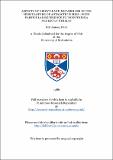Files in this item
Aspects of growth and metabolism in the musculature of Antarctic fishes : with particular reference to 'Notothenia neglecta' nybelin
Item metadata
| dc.contributor.advisor | Johnston, Ian A. | |
| dc.contributor.advisor | White, M. G. | |
| dc.contributor.author | Fitch, Neil Antony | |
| dc.coverage.spatial | 235 p. | en_US |
| dc.date.accessioned | 2018-07-05T12:39:12Z | |
| dc.date.available | 2018-07-05T12:39:12Z | |
| dc.date.issued | 1986 | |
| dc.identifier.uri | https://hdl.handle.net/10023/14989 | |
| dc.description.abstract | 1. Aspects of the physiology and biochemistry of Antarctic fish muscle have been examined, principally for the nototheniid, Notothenia neglecta Nybelin. 2. Sampling was most successful during the late summer/autumn. The trammel net was the best method for catching fish above 200mm standard length. Smaller fish were best caught by SCUBA divers using hand-nets. 3. The condition factor for fish caught was highest during the summer (high food availability) and remained low during the winter months. Analysis of trunk muscle constituents (water, protein, lipid) indicated no evidence for marked depletion at any time of the year. Seasonal variation in relative gonad size and relative liver size were observed. 4. Metabolically the pectoral abductor muscle of N.neglecta had higher activities of anaerobic and aerobic enzymes than either the red or white trunk muscles. This is in line with the fact that this species normally swims using enlarged pectoral fins, while sprint swimming in short bursts is carried out by the white trunk muscle. 5. Differences in the metabolic profiles of the trunk muscles of 3 Antarctic species (N.neglecta, Notothenia gibberifrons and Trematomus newnesi) are related to their different lifestyles, particularily feeding behaviours. 6. Muscle growth in N.neglecta is probably both by hypertrophy, and recruitment of myosatellite cells. Both the fibres and capillaries in Antarctic species are much larger in cross-sectional area than for temperate species. 7. Lactate dehydrogenase isozymes in the trunk and cardiac muscles of N.neqlecta are electrophoretically and kinetically similar. This, along with its high activities of anaerobic enzymes indicates that the cardiac muscle is adapted to utilise fuels anaerobically if necessary. 8. The majority of physiological and cellular adaptations can be explained on the basis of physiological/ecological constraints rather than cold temperature per se. | en_US |
| dc.language.iso | en | en_US |
| dc.publisher | University of St Andrews | |
| dc.subject.lcc | QL638.N6F5 | en |
| dc.subject.lcsh | Nototheniidae | en |
| dc.title | Aspects of growth and metabolism in the musculature of Antarctic fishes : with particular reference to 'Notothenia neglecta' nybelin | en_US |
| dc.type | Thesis | en_US |
| dc.type.qualificationlevel | Doctoral | en_US |
| dc.type.qualificationname | PhD Doctor of Philosophy | en_US |
| dc.publisher.institution | The University of St Andrews | en_US |
This item appears in the following Collection(s)
Items in the St Andrews Research Repository are protected by copyright, with all rights reserved, unless otherwise indicated.

